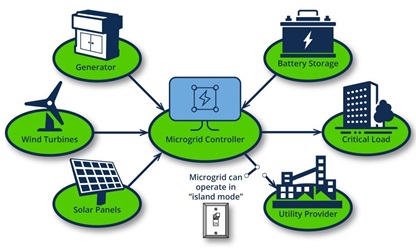Microgrid are self sufficient and localized energy systems that can operate independently or in conjunction with the main grid. They are designed to generate, distribute, and control the flow of electricity within a limited geographical area, such as a community, university campus, hospitals, military base, or industrial complex. They can incorporate various energy sources, including renewable energy such as solar, wind, and hydro, as well as conventional fossil fuels or energy storage systems.

(PC-nsci.ca)
Characteristics of Microgrid
Energy Sources
Microgrid utilize a diverse range of energy sources, including solar, wind, hydro, and biomass. By incorporating renewable resources, they reduce reliance on fossil fuels, thereby decreasing carbon emissions and promoting environmental sustainability.
Energy Storage
One key feature of these grids is their ability to store excess energy for later use. Batteries, capacitors, and flywheels are commonly employed to store electricity generated during periods of low demand, ensuring a reliable power supply during peak times or in the event of grid outages.
Control Systems
Sophisticated control systems are the backbone of this grid operation. These systems monitor energy production and consumption in real-time, optimizing the flow of electricity to meet demand while minimizing waste. Automation plays a crucial role in ensuring the seamless integration of various energy sources and storage technologies.
Advantages of Microgrids
Resilience
They offer increased resilience against power outages and natural disasters. Their decentralized nature ensures that even if one component fails, the rest of the system remains operational. This resilience is particularly valuable in remote areas or critical facilities where uninterrupted power is essential.
Energy Efficiency
By generating and distributing power locally, these grids reduce energy losses associated with long-distance transmission. Additionally, their ability to capture waste heat for cogeneration purposes further enhances efficiency, making them an attractive option for energy-conscious consumers.
Cost Savings
The modular nature of these grids allows for incremental expansion, enabling users to scale their systems according to evolving needs. This flexibility not only reduces upfront costs but also provides long-term savings through optimized energy management and reduced reliance on external utilities.
Applications of Microgrids
Remote Areas
In remote or off-grid locations, these grids offer a lifeline by providing reliable access to electricity where traditional grid infrastructure is lacking. Whether powering rural communities, mining operations, or agricultural facilities, microgrids enable sustainable development and improve quality of life.
Industrial Facilities
Industrial facilities often have high energy demands and stringent reliability requirements. These grids offer a tailored solution by providing uninterrupted power for critical processes, enhancing productivity, and reducing downtime.
Military Bases
Military installations require secure and resilient energy systems to support mission-critical operations. These grids enhance energy security by reducing dependence on vulnerable external sources and ensuring continuity of operations in the face of disruptions.
Challenges Facing Microgrids
Integration Issues
Integrating diverse energy sources and storage technologies into a cohesive grid system can be complex. Interoperability standards and compatibility issues must be addressed to ensure seamless operation and optimize performance.
Regulatory Hurdles
Regulatory frameworks often lag behind technological advancements, posing barriers to the widespread adoption of these grids. Streamlining permitting processes and incentivizing investment in distributed energy infrastructure are essential for fostering growth in this sector.
Cybersecurity Risks
As these grids become increasingly interconnected and digitized, they become vulnerable to cyber threats. Safeguarding against attacks and ensuring the integrity of critical infrastructure requires robust cybersecurity measures and ongoing vigilance.
Future Trends in Microgrid Technology
Advanced Control Systems
Advancements in artificial intelligence and machine learning are driving the development of more sophisticated control systems for microgrids. These systems optimize energy management, anticipate demand patterns, and adapt to changing conditions in real-time.
Renewable Energy Integration
The continued expansion of renewable energy sources presents opportunities for enhancing the sustainability of microgrids. Integrating solar, wind, and other renewables into microgrid designs reduces reliance on fossil fuels and accelerates the transition to a low-carbon energy future.
Blockchain Technology
Blockchain technology has the potential to revolutionize energy transactions within microgrid networks. By enabling secure peer-to-peer energy trading and transparent accounting, blockchain platforms empower consumers to participate actively in energy markets and optimize their usage patterns.
Conclusion
Microgrids represent a paradigm shift in energy management, offering resilience, efficiency, and sustainability in a decentralized framework. While challenges remain, ongoing innovation and collaboration are driving the widespread adoption of microgrid technology, paving the way for a more resilient and sustainable energy future.
FAQs
- What distinguishes microgrids from traditional power grids?
Microgrids are localized power systems that can operate independently or in conjunction with the main grid, offering increased resilience, efficiency, and flexibility compared to centralized grids. - How do microgrids contribute to sustainability?
By incorporating renewable energy sources and optimizing energy management, microgrids reduce carbon emissions, minimize energy losses, and promote environmental stewardship. - What role does energy storage play in microgrid operation?
Energy storage systems enable microgrids to store excess energy for later use, ensuring a reliable power supply during peak demand periods or grid outages. - What challenges do microgrids face in terms of regulatory compliance?
Regulatory frameworks often lag behind technological advancements, posing barriers to the widespread adoption of microgrids. Streamlining permitting processes and incentivizing investment are essential for fostering growth in this sector. - How can blockchain technology enhance microgrid functionality?
Blockchain technology enables secure peer-to-peer energy trading and transparent accounting within microgrid networks, empowering consumers to participate actively in energy markets and optimize their usage patterns.